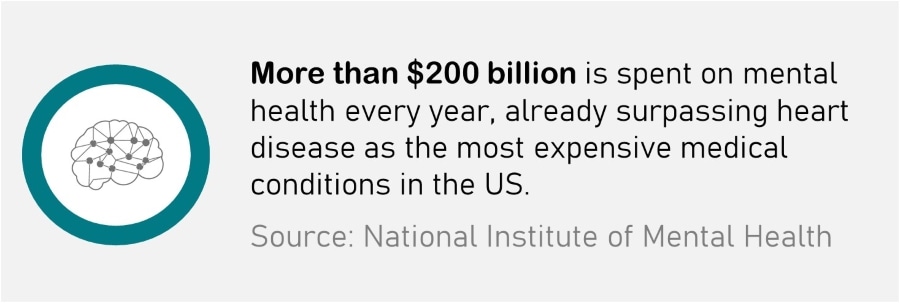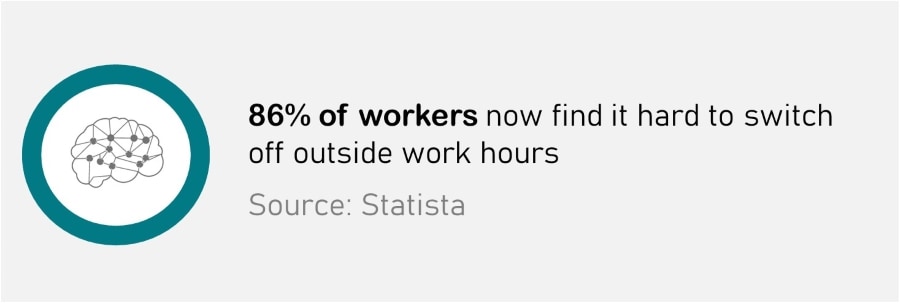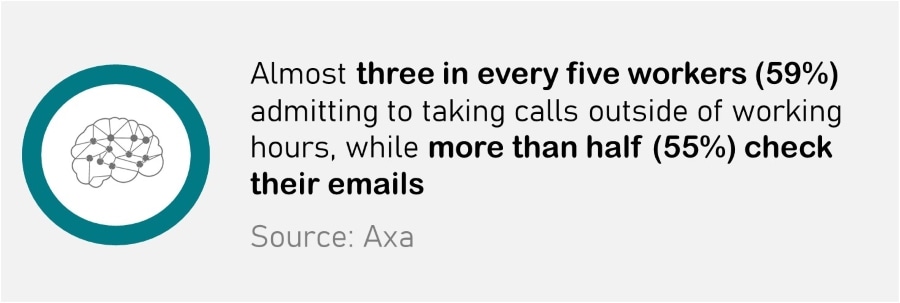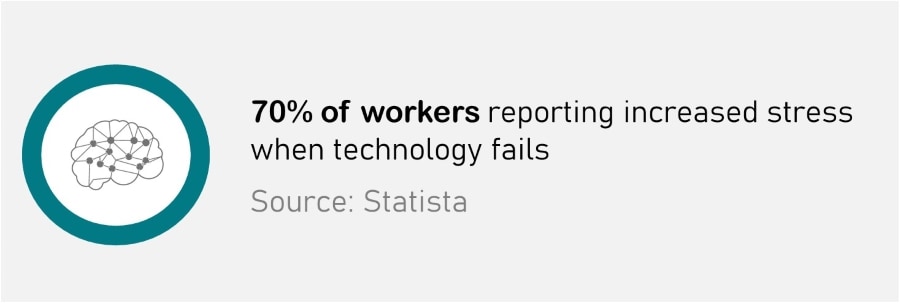What are the effects of technology on Mental Health and Well-Being in the workplace?

Technology has aided the advancement of our world in more ways than we could have imagined. But, for all of its benefits in making life easier and our judgment smarter, it’s important not to ignore the effects of technology on mental health and well-being in the workplace as technology use increases.
While workplace innovations can make work easier and faster, these data show that people are working even harder and for longer hours to meet these higher demands, which leads to stress, worry, and burnout.
But this does not have to be the case. There are numerous and largely untapped potential to employ technology in the workplace to safeguard and improve mental health while simultaneously reaping the productivity and financial benefits that these technologies may provide.
What is the effect of technology on employee well-being and mental health?
Businesses have gained significant commercial and productivity benefits thanks to workplace technologies such as cloud, communication, and collaboration tools. However, organizations must consider using technology to foster a positive workplace culture and support employees’ mental health and well-being.
Good practice must begin at the top, with leaders and managers modelling healthy behaviors and advocating responsible technology usage, such as taking regular breaks and yearly leave and not responding to emails sent after hours. A lack of these, can can cause a detrimental effect of technology on employee well-being and mental health.

Constant Availability
There’s a lot to be said about technology’s continual availability. It can keep us up to date no matter where we are in the world and make us available when we are most needed.
While this is a great thing, it also means that many bosses want their employees to be reachable after hours. This might be anything from responding to a client’s text to doing a late video call.
This accessibility might be stressful for many people because it never allows them to turn off completely.
One of the downsides of using technology in the office is the culture of always being reachable. But, once again, it isn’t all bad.
Employees’ ability to pick up the phone and video call clients halfway around the world can provide organizations with access to global marketplaces.
Too Much Screen Time
Spending prolonged periods in front of a laptop screen might cause eye strain and weariness. Tired employees find it difficult to concentrate, leading to underperformance on assignments.
Though laptops and computers are now required in many workplaces, it might be argued that they are harming employees’ health.
Employees are advised to take regular breaks away from their devices, but this is rarely followed. Employees are under too much pressure to accomplish their workload, and there is frequently little time to take a break and return to work.
Too much screen time can negatively influence both mental and physical health, and without sufficient back support might lead to back problems.
Many office workers claim back pain as a direct result of their jobs. Furthermore, employees may suffer from repetitive strain injury (RSI). This occurs when the same motion is performed several times, causing discomfort in the muscles, nerves, and tendons.

Inability to Wind Down
When we are connected to technology, our minds do not turn off. While we may not be aware of it, we instinctively look for incoming texts and emails.
This incoming information can be stressful, prompting employees to stay concerned about their jobs even after leaving the office. When they go home, it may be difficult for them to unwind and forget about work until the next day.
This can significantly influence someone’s mental health since they cannot get a good night’s sleep because they are worried about work.
This persistent level of stimulation increases the likelihood of depression and anxiety. They can stem from emotions of inadequacy or being programmed to believe that something significant will occur at any time.
Workplace communication tools have played a significant role in our always-on culture, allowing us to check emails, connect with colleagues, and track KPIs.
This can be good if utilized wisely, but it can lead to overwork when the distinctions between business and personal life become blurred. And the impact on our mental health is undeniable.
Though work-related stress can be present in every job role even when no technology is present, it can undoubtedly be amplified in circumstances where technology is prevalent.

How business can ensure workplace technology helps mental and emotional well-being
Given the prevalence of technology in many workplaces, it is sensible for managers and bosses to take a step back and assess the negative impact of technology on their employees.
People are what make a business, and employers have a significant responsibility to ensure their physical and mental well-being. With wireless technology, Smart workplace designs can allow employees to modify lighting settings to promote attention and reduce stress.
RELATED: The Futuristic Office: A technical evolution of the workspace
Before investing in and deploying workplace technologies, HR teams and business leaders must address potential well-being issues, considering that poor planning, communication, and lack of training on new systems adversely affect workers.
Here are some areas in which HR and Technology teams can collaborate to ensure that technology and well-being are in sync.
The Office Environment
Subtle workplace innovations that improve office culture and instil positive work habits are worth investigating.
Ergonomic and flexible desk considerations
Even sitting in a chair all day can cause mental health problems, and therefore, employees should be encouraged to move and be active.
This can be achieved, for example, by Investing in a sit/stand desk may help to alleviate the strain that comes with sitting at a desk all day. Another possibility, which is less expensive than a standing desk, is a desktop laptop stand/riser which sits on your current desk and lets you raise and lower a laptop.
Other cost-effective solutions and more popular options are ergonomic chairs and monitor arms or stand to ensure correct sitting posture, helping relieve tiredness and contribute to improved well-being amongst the workforce.
Adjusting your keyboard and mouse
Repetitive stress injury (RSI), also known as repetitive motion injury or cumulative trauma, occurs when a person repeatedly performs the same motion while performing work tasks. This repetition can cause muscle, tendon, and nerve strain, leading to chronic pain and other issues.
If you don’t have a good typing position, you could have a lot of aches and pains, which can become a serious problem over time.
Fortunately, ergonomic keyboards are designed to assist you in typing in the most ergonomic way possible, avoiding repetitive strain injuries.
The best ergonomic keyboards include wrist rests and typically come in one of two shapes: a split keyboard with slightly angled sides or a keyboard with a built-in comfort curve.
Similarly, ergonomic mice and input devices are designed to provide a more natural hand position and grip. These can come in many forms, including vertical mice, trackball mice, trackpads and joystick input devices. You can also slow down your mouse in the system settings to help reduce muscle tension.
Applications and Tools
The urge to work longer hours and check emails more frequently is difficult to resist. However, there are applications and tools available that can notify employees to take breaks, helping to reduce overwork and foster a positive workplace culture.
Analytics & monitoring
Platforms like Office 365 now include new capabilities like ‘My Analytics,’ which allow employees to track and manage their time more effectively.
Furthermore, regular well-being surveys and mental health programmes and groups within the business provide employees with the assistance and counsel they require 24 hours a day, seven days a week.
Organizations and business leaders can improve employees’ entire well-being through technology. Therefore, we must collaborate to make the most of it.
Wearable Devices
Furthermore, wearable-assisted apps and devices can be used to track employee stress levels. Stress signals can be detected by analyzing data such as perspiration and breathing patterns.
Employers can then send solutions and other helpful information to their employees’ phones.
Well-Being Apps
There are also technological developments such as Off the Grid, an app that lets users turn off their gadgets. Instagram employs the same approach in its recall feature, which warns users to exit the app after a predetermined time.
Numerous mindfulness and meditation apps are available, and managers are beginning to use these tools to build better office environments.
Technology Trends to improve Employee Mental Health and Well-Being
Artificial intelligence is another technology with significant potential for improving workplace mental health.
For example, the AI chatbot Woebot may replicate talks with therapists and can even be customized to the user’s exact needs. Employees and management can use AI to design tailored mental health care plans, anticipate crises, and look for emerging patterns that will aid in resolving issues before they occur.
RELATED: Business benefits of artificial intelligence
While some are concerned about the impersonality of AI-assisted technology, employees who choose discretion will benefit from anonymity and personalization.

Key Takeaways
After some early adapting, employees continued working from home, largely undisturbed by the sudden change to complete remote working.
However, because of this entirely digital experience, many employees find it difficult to shut off from work. Remote workers who feel cut off from communication channels and support mechanisms are more likely to suffer mental health difficulties.
From the debut of smartphones to warehouse robots, there are several ways in which life would not be the same without technology. However, there is a downside to all of technology’s advantages. It can harm our physical and mental well-being and our daily life.

